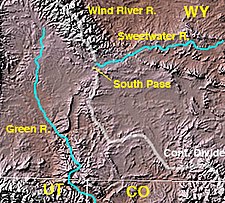| South Pass | |
|---|---|
 Historic South Pass, seen from the east looking westward towards Pacific Springs | |
| Elevation | 7,412 ft (2,259 m) |
| Traversed by | Oregon Trail, California Trail, and Mormon Trail, Wyoming Highway 28 |
| Location | Fremont County, Wyoming United States |
| Range | Wind River Range and Antelope Hills (Radium Springs, Wyoming) |
| Coordinates | 42°22′12″N 108°54′49″W / 42.37000°N 108.91361°W |
| Topo map | USGS Pacific Springs |
South Pass | |
 Map of southwestern Wyoming showing location of South Pass at the headwaters of the Sweetwater River | |
| Nearest city | South Pass City, Wyoming |
| NRHP reference No. | 66000754 |
| Significant dates | |
| Added to NRHP | October 15, 1966[1] |
| Designated NHL | January 20, 1961[2] |
South Pass (elevation 7,412 ft (2,259 m) and 7,550 ft (2,300 m)) is a route across the Continental Divide, in the Rocky Mountains in southwestern Wyoming. It lies in a broad high region, 35 miles (56 km) wide, between the nearly 14,000 ft (4,300 m) Wind River Range to the north and the over 8,500 ft (2,600 m) Oregon Buttes[3] and arid, saline near-impassable Great Divide Basin to the south. The Pass lies in southwestern Fremont County, approximately 35 miles (56 km) SSW of Lander.
Though it approaches a mile and a half high, South Pass is the lowest point on the Continental Divide between the Central and Southern Rocky Mountains. The passes furnish a natural crossing point of the Rockies. The historic pass became the route for emigrants on the Oregon, California, and Mormon trails to the West during the 19th century. It was designated as a U.S. National Historic Landmark on January 20, 1961.
- ^ "National Register Information System". National Register of Historic Places. National Park Service. April 15, 2008.
- ^ "South Pass". National Historic Landmark Program. National Park Service. Archived from the original on April 13, 2008. Retrieved June 27, 2008.
- ^ Oregon Buttes, Wyoming, Elevation: 8558 feet, 2608 meters, peakbagger.com

